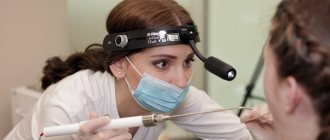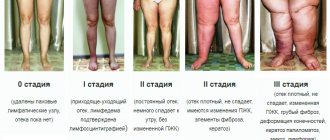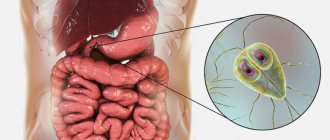Published: 10/22/2021 15:15:00 Updated: 10/25/2021
Sore throat is a disease of an infectious nature, manifested by acute inflammation of the lymphoid tissue of the pharynx. Most often the process affects the palatine tonsils, but other structures of the lymphadenoid pharyngeal ring can also be affected - the lingual and pharyngeal tonsils, lateral ridges or granules of the posterior pharyngeal wall.
The pathology in question is characterized by symptoms of intoxication, increased general temperature, sore throat that worsens during swallowing, enlarged and painful cervical lymph nodes. The palatine tonsils and arches are swollen, enlarged, bright red, and may have a white or dirty yellow coating.
Treatment of sore throat includes local treatment with antiseptics, painkillers and anti-inflammatory drugs, antibiotic therapy and detoxification measures. If complications develop or the process becomes chronic, surgical intervention may be required.
Description of the disease
Follicular tonsillitis is a moderately severe variant of tonsillitis that can affect both infants and adolescents 15-18 years old.
Boys and girls are equally susceptible to pathology. According to statistics, this disease occurs in 8-15% of children. The disease is characterized by acute development, but with timely consultation with a doctor, it is accompanied by complete recovery in 90-92% of cases. The danger of the disease lies in possible complications:
- Acute rheumatic fever. When the cardiovascular system is damaged, the valve apparatus of the heart suffers. Acquired defects develop, which, if left untreated, change first the intracardiac and then the systemic hemodynamics of the patient.
- Formation of peritonsillar abscesses. In the area of the palatine tonsils, ulcers of different sizes form, which are a source of infection and can cause pathogenic bacteria to penetrate into the membranes of the brain (with the bloodstream).
- Infectious arthritis. Bacteria from the palatine tonsils penetrate into the joint cavity through the vascular bed. There they create foci of local inflammation, cause pain, and reduce the child’s range of free movements.
- Nephritis. Kidney damage is an uncommon complication (up to 6-7% of cases). It is characterized by the formation of a focus of chronic infection in the kidneys, which cannot always be completely eliminated.
When microorganisms penetrate the membranes of the child’s brain, meningitis develops.
The disease directly threatens the patient's life and requires hospitalization in the intensive care unit. Therefore, each episode of follicular tonsillitis should be under the supervision of a doctor. A child does not always need hospitalization. However, it is important for a specialist to assess the condition and determine further therapeutic tactics.
Symptoms of follicular tonsillitis in children
Follicular tonsillitis, like most other forms of tonsillitis, debuts with a sore throat (this picture is observed in 80% of cases). Discomfort occurs acutely - on the first day after exposure to the provoking factor. The intensity of pain varies from mild to severe. This depends on the individual characteristics of the child’s body, the aggressiveness of microorganisms and the activity of the immune system. Associated symptoms of follicular tonsillitis in children:
- Fever with an increase in body temperature to 38-39°C.
- Swallowing disorder. A sore throat can make it difficult for a child to eat or even drink. Infants often refuse to breastfeed and cry constantly.
- An increase in size of the palatine tonsils with the appearance of mucosal hyperemia.
- Foci of gray-white plaque form on the surface of the tonsils. When touched, they are easily removed with a cotton swab.
- Lymphadenitis is an increase in the size of nearby lymph nodes.
- General weakness, moodiness, disturbance of normal sleep.
Follicular tonsillitis is characterized by alternating episodes of severe weakness, which coincide with an increase in temperature, and the patient’s normal state of health. Hospitalization of children with this disease is carried out in case of a sharp deterioration in condition or persistent fever that cannot be treated with antipyretic drugs at home.
General overview
Follicular tonsillitis (according to ICD 10: code J 03) is one of the four forms of acute tonsillitis (from the Latin tonsillae - tonsil).
Catarrhal tonsillitis is the mildest course of the disease, in which the palatine tonsils are enlarged, full of blood, but there is no purulent discharge on them, and the patient’s general well-being suffers slightly. The risk of complications is minimal.
Catarrhal sore throat photo
Follicular - “islands” of white purulent discharge are noted on enlarged tonsils; they are easily removed during examination by an ENT doctor. Lacunar - “islands” merge into dense yellowish deposits covering the tonsils in the form of “rivulets”.
Follicular sore throat photo
Membranous-necrotic - purulent plaques form dense films covering not only the tonsils, but also the surrounding tissues of the oropharynx.
Membranous necrotic sore throat photo
As the manifestations of the disease increase, the patient’s state of health worsens to severe, and the risk of immediate and delayed complications increases.
Causes of follicular tonsillitis in children
The palatine tonsils are the first barrier to various microorganisms that enter the patient’s respiratory tract.
They are accumulations of lymphoid tissue rich in immune cells that protect a person from bacteria and viruses. Follicular tonsillitis is the result of a “breakdown” in the function of the palatine tonsils. This can occur either against the background of massive infection with microorganisms, or with an existing immunodeficiency. In both cases, bacteria and viruses (most often group A streptococci) penetrate the lymphoid tissue and begin to multiply. The tonsils turn from a protective organ into a source of infection, which can penetrate various organs through the bloodstream.
The disease is based on a local inflammatory process. Against the background of vasodilation, the tonsils become red and increase in size. Gray-white films are the result of the vital activity of microorganisms. An increase in their number is an unfavorable sign indicating the progression of the disease.
Factors that create conditions for easier penetration of bacteria and viruses into the palatine tonsils are:
- Hereditary predisposition.
- Hypothermia – local and systemic.
- Congenital or acquired immunodeficiency.
- Exacerbation of chronic diseases of other internal organs (cholecystitis, pancreatitis, pyelonephritis).
- Metabolic disorders (diabetes, obesity).
- Chronic processes in the paranasal sinuses of a child (sinusitis, sinusitis, ethmoiditis), otitis media, multiple carious teeth.
Follicular tonsillitis in children is rarely primary. The disease often occurs against the background of an already suffered catarrhal form of the disease.
Complications of sore throat
Patients with angina may experience the following local complications: peritonsillitis and peritonsillar abscess, otitis media, etc. They usually occur in people whose treatment was started relatively late - after the 3rd day from the moment of illness. Peritonsillitis and paratonsillar abscess have similar symptoms, which include: high fever, predominance of unilateral pain in the oropharynx, sharply intensifying when swallowing, increased salivation, trismus and pain when opening the mouth, unilateral edema, hyperemia of the soft palate, swelling of the palatine arch on the affected side, and also a shift to the center of the affected tonsil and asymmetry of the uvula.
In addition to local complications, angina can cause metatonsillar diseases - rheumatism, infectious-allergic myocarditis and polyarthritis, cholecystocholangitis. With modern approaches to the treatment of patients with tonsillitis, rheumatism and polyarthritis, it is more often possible to avoid other metatonsillar diseases (for example, glomerulonephritis in 0.8% with primary tonsillitis and in 3.0% with a recurrent form of the disease).
Myocarditis develops with primary angina in the first days of the convalescence period, and with repeated angina - from the first days of the disease. This complication rarely manifests itself with the classic symptoms of this disease. Most often, the only signs of myocarditis are persistent changes in the electrocardiogram, indicating focal damage to the heart muscle, and a moderate increase in the 1st-2nd fractions of lactate dehydrogenase.
The development of glomerulonephritis corresponds to the time of formation of autoimmune (against kidney tissue) and immunopathological factors on the 5–6th day of normal body temperature (8–10th day of the disease). Glomerulonephritis occurs without extrarenal symptoms. Its only manifestation is persistent urinary syndrome in the form of moderate proteinuria (0.033–0.099 g/l), leukocyturia (10–50 cells per field of view in a urine sediment specimen), erythrocyturia (3–20 cells per field of view) and cylindruria .
Diagnosis of follicular tonsillitis in children
Making a diagnosis of “follicular tonsillitis” is not difficult for an ENT doctor.
At the initial consultation, the doctor assesses the general condition, collects an anamnesis of the disease, and analyzes the complaints of the patient and his parents. After this, pharyngoscopy is mandatory. Using a light source and a special mirror, the ENT examines the oropharynx and palatine tonsils. When they increase and the presence of typical gray-white plaques, a diagnosis of follicular tonsillitis is established.
To assess the severity of the disease and identify possible concomitant diseases, a comprehensive examination is carried out:
- General and biochemical blood test. Based on the results of these tests, the doctor determines the severity of the inflammatory process and monitors liver and kidney function.
- Sowing a smear from the palatine tonsils onto a nutrient medium. This method allows you to accurately identify the causative agent of sore throat and select the optimal antibacterial drug.
Polymerase chain reaction (PCR) can also be used to identify the pathogen.
The technique is based on the ability to detect RNA or DNA particles of pathogenic microorganisms. If abnormalities in the functioning of other organs and systems are detected, the child is examined by related specialists (pediatrician, ophthalmologist, gastroenterologist).
Diagnostics
Methods for treating sore throat differ significantly from ARVI and influenza, although the disease is similar to viral diseases. It is important to conduct an individual diagnosis in a timely manner and prescribe treatment from specialists.
During the consultation, the doctor finds out the signs of pain of the sick person and conducts a full examination of the oral cavity. Effective examination is carried out using special equipment with lighting.
The general examination procedure allows the doctor to see enlarged lymph nodes and, if a disease is suspected, to do tests to find the causative agent of a sore throat.
Treatment of catarrhal tonsillitis in children
Follicular tonsillitis is one of the forms of tonsillitis that responds well to conservative treatment. With the help of medications, in 90-95% of cases it is possible to achieve the desired result. The main thing is to start taking the right medications on time.
Conservative treatment
The main goal of drug treatment of follicular tonsillitis in children is to “cleanse” the palatine tonsils from pathogenic microorganisms and strengthen the body’s immune defense. For this purpose, the following groups of drugs are used in otolaryngology:
- Antibiotics. Mandatory group of drugs. Broad-spectrum agents are traditionally prescribed early in treatment (before culture results are available). This allows you to effectively destroy bacteria without even identifying the exact pathogen.
- Rinse and irrigate the oropharynx with local antiseptics. Most often this is an aqueous solution of iodine, various sprays with anesthetics that help reduce the severity of pain in a child and improve swallowing.
- Non-steroidal anti-inflammatory drugs (NSAIDs). Prescribed to suppress an excessive inflammatory response and reduce the child’s body temperature.
It is recommended to use vitamin complexes to strengthen the defenses.
Surgery
Surgical interventions for follicular tonsillitis may be indicated when abscesses form in the area of the palatine tonsils. Peritonsillar abscesses are dangerous due to rupture with the penetration of pus into the vessels supplying the brain. Therefore, they are opened, the contents are removed and the wound is drained.
Prevention of sore throat
In addition to general restorative therapy and measures aimed at preventing infection, preparations of bacterial origin, in particular complexes of antigens - lysates, the most common causative agents of inflammatory diseases of the upper respiratory tract, oral cavity and pharynx, have proven to be an effective means of preventing exacerbations in various forms of pharyngitis and recurrent tonsillitis. It is possible to use similar drugs with systemic action, but this group of drugs has a greater number of contraindications.
It should be noted that all patients suffering from chronic tonsillitis who have had more than 2 sore throats over the past 3 years are subject to mandatory follow-up in group D3, that is, 2 times a year.
Questions
- Which doctor treats follicular tonsillitis in children?
An otolaryngologist is involved in identifying and treating follicular tonsillitis in children. - Is it possible to treat a sore throat on your own?
Independent choice of drugs for follicular tonsillitis in children under 3-4 years of age is extremely undesirable. Due to early age, many medications cannot be used in adequate doses. This leads to incorrect treatment. You can overcome a sore throat at home. However, in all cases, an in-person consultation with an otolaryngologist is required. This will help avoid the development of serious complications. - Does traditional medicine help with follicular sore throat?
Traditional medicine can have a positive effect in the presence of sore throat. However, it must be borne in mind that in case of high body temperature and pronounced signs of intoxication, antibacterial drugs should be prescribed in 100% of cases. It turns out that with follicular tonsillitis you can do without traditional medicine, but you cannot do without antibiotics. Therefore, in most cases, otolaryngologists do not recommend the use of non-traditional approaches due to the risk of losing valuable time. - Are anesthetic sprays harmful to children?
Anesthetic components in antiseptic sprays are contained in minimal doses. They are external anesthetics approved for use in pediatric practice. Therefore, to relieve pain in follicular tonsillitis, such sprays can be used in complex treatment.
Sources
- Clinical recommendations (treatment protocol) for the provision of medical care to children with tonsillitis (acute streptococcal tonsillitis) FSBI NIIDI FMBA RUSSIA, State Budgetary Educational Institution of Higher Professional Education Krasnoyarsk State Medical University named after. prof. V.F. Voino-Yasenetsky, Ministry of Health of the Russian Federation, Municipal Budgetary Institution of the City Children's Clinical Hospital No. 1 (Krasnoyarsk).
- Modern possibilities of antibacterial therapy in children with chronic tonsillitis. / E.P. Karpova, M.P. Bozhatova. // Russian. Medical journal. – 2010. – T. 18, No. 1. – P. 8-10.
- Acute tonsillitis in childhood: diagnosis and treatment. /VC. Tatochenko, M.D. Bakradze, A.S. Darmanyan. // Pharmateka. - 2009. - No. 14. - P. 65-69.











